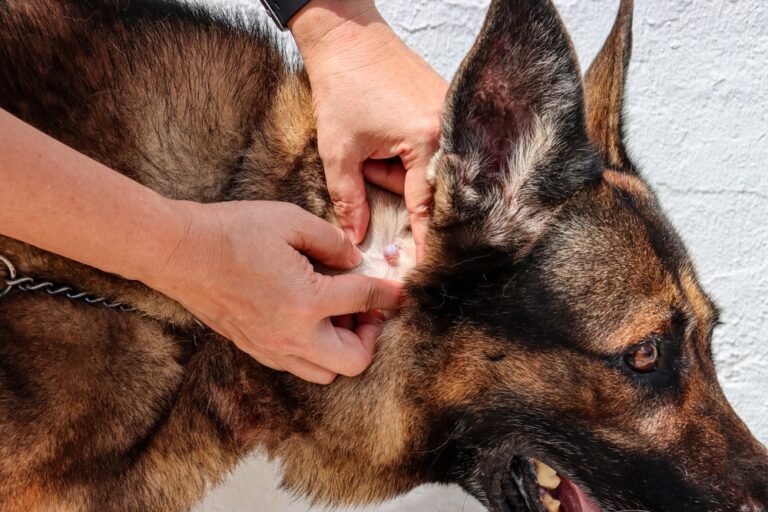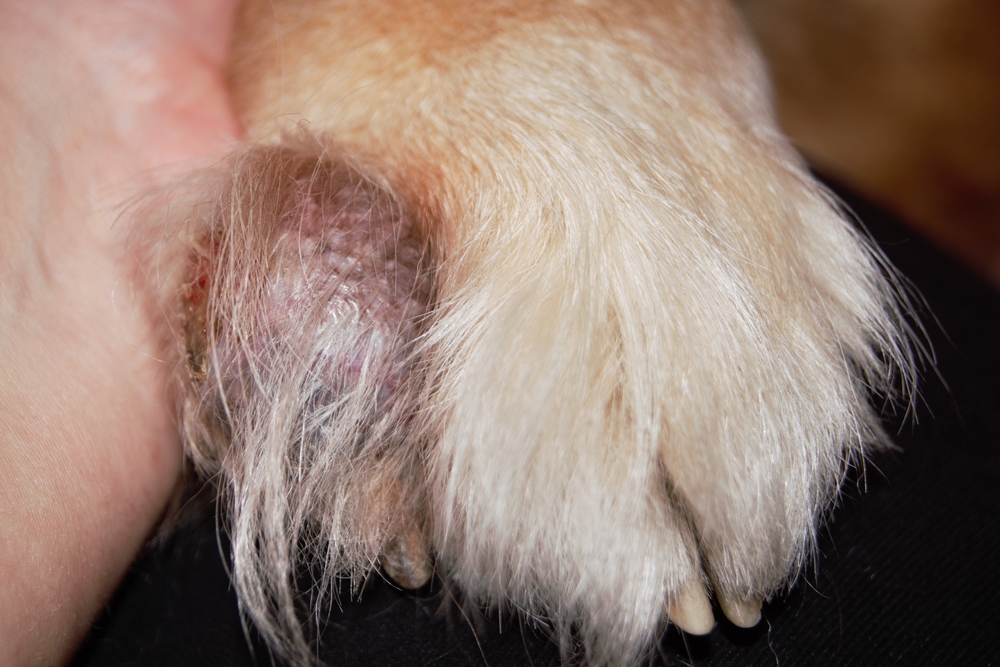Types of Cysts on Dogs

It can be concerning to discover a lump or bump on your dog. Many people fear a serious diagnosis is around the corner, but not all lumps and bumps are cancerous. In fact, many simply turn out to be benign cysts. Several types of cysts can develop in dogs, and some breeds are predisposed to them. Nevertheless, having any lumps evaluated by a veterinarian is essential so an accurate diagnosis can be made and appropriate treatment can begin.
What is a Dog Cyst?

A cyst is an enclosed pocket of tissue that forms within the skin and is filled with fluid or solid material. Cysts are most commonly found by pet parents when they are petting or brushing their dogs.
Cysts and tumors can occur in various locations on a dog’s body. While they may look similar because they are round and protrude from the skin, several key differences exist. While cysts tend to develop slowly over time, the growth rate of tumors can vary. Cysts on dogs are generally soft (although some can feel slightly firm), while tumors are mostly solid and not easily moveable. Cysts are benign, while tumors can be cancerous. Treatment options for cysts and tumors are vastly different, so it is important to consult a veterinarian for an accurate diagnosis.
What Causes Dog Cysts?
Cysts can develop for various reasons, including inflammation, trauma, and excessive grooming. Sometimes, hair follicles and skin glands become clogged and lead to cyst formation. Cysts can occur in dogs of any age, and some breeds have a genetic predisposition for them. They are especially common in Cocker Spaniels, Boxers, Golden Retrievers, and Schnauzers.
Types of Cysts on Dogs

Many types of cysts can be found on dogs. Because many lumps and bumps look similar, a visit to the veterinarian is required to identify which type your dog may have.
True Cyst
True cysts are lumps containing accumulated fluid secreted by cells within their lining. These types of cysts on dogs can vary in size depending on how long they are present and are usually soft due to the accumulated fluid. True cysts are not harmful to dogs but can be bothersome depending on their location and size. If punctured, they can leak fluid, which may dry and form crusts on the surrounding fur.
Follicular Cyst
Follicular cysts arise from the hair follicles of dogs, and they can be found on many parts of the body, especially the muzzle. Follicular cysts are small, round lumps slightly firm to the touch. They are typically filled with a thick material known as keratin, which may ooze out if the cyst is punctured. They are usually not painful for dogs but can become itchy and infected.
Sebaceous Cyst
Sebaceous cysts arise from sebaceous glands that secrete a thick, oily sebum. When this substance builds up within the gland, cyst formation can occur. Sebaceous cysts can be found anywhere on the body, especially the head, neck and eyelids. They can vary in size and typically contain an oily fluid or a thick, white-to-yellow material. They are generally harmless but can become inflamed and irritated in some instances.
Interdigital Cyst

Interdigital cysts are found on a dog’s paw between their toes. These types of cysts on dogs are typically firm and not easily moveable. They are small to medium and can become irritated and inflamed because dogs frequently lick them. They may also bleed or ooze thin, clear-to-yellow fluid. They are benign but can be painful for dogs depending on the cyst’s size and location on the paw. These cysts also tend to be associated with infections.
Dermoid Cyst
A dermoid cyst is a congenital abnormality that occurs due to abnormal development. These cysts contain keratin, a thick material that usually makes up skin and hair. They can appear in groups or as a single cyst; many have hair follicles protruding from their center. Rhodesian Ridgebacks and Boxers are predisposed to having these cysts [1].
Diagnosing Types of Cysts on Dogs
To diagnose the type of cyst your dog has, a veterinarian will first complete a physical exam and note defining characteristics, such as size and location, of the lump. Then, the veterinarian will take a small sample using a needle. The sample is viewed under a microscope, and if the cells are characteristic of a cyst, the veterinarian can make a preliminary diagnosis and offer treatment options.
Depending on the type of treatment recommended, bloodwork may be done to assess the dog’s overall health, and the sample can be sent to a pathologist for additional testing and review. An accurate diagnosis of any lumps or bumps on a dog’s skin is important to ensure the appropriate treatment option is offered.
Treating Cysts on Dogs

Some cysts may not require treatment at all. However, if a cyst warrants treatment, possible options include topical or oral medications, draining of fluid, and surgery. Medications may include antibiotics or anti-inflammatory medications, particularly if a bacterial infection occurs. For some cysts, draining the accumulated fluid or thick material using a syringe can provide relief, especially if the cyst is located in a high-pressure area or restricts movement. Unfortunately, simply draining the cyst is only a temporary solution, and the cyst will eventually refill.
Surgical removal is often recommended for cysts that are unresponsive to other treatment options or that continue to refill. During surgery, the outer layer and all enclosed material is removed. The surgery uses general anesthesia, so it may not be an option for all dogs, particularly those with underlying medical conditions. Dogs typically tolerate cyst removal surgery and recovery well. Pain medication is usually prescribed to be given at home, and in some instances, antibiotic therapy may also be started. A recheck appointment between 10-14 days following surgery is usually done to ensure the incision site is healing well and there are no new concerns with the area.
FAQs About Dog Cysts

Can a dog cyst burst?
Yes, cysts on dogs can rupture. Sometimes, this occurs from self-trauma due to the dog licking or itching the affected area. Other times, pressure from the fluid or material within the cyst becomes so high that it causes the skin to separate, forming a small opening where it can leak. Pet parents typically notice that a cyst on their dog has ruptured due to the dried crusts and matted fur that form in the surrounding area.
What should I do about a ruptured cyst on my dog?
If pet parents notice a cyst on their dog has ruptured, they should visit a veterinarian for treatment. The veterinarian can clean the cyst area to ensure an infection does not develop and provide pain management and topical medications to help keep the dog comfortable. A bandage may also be applied to keep the area clean and dry while it heals. This also allows the veterinarian and pet parent to discuss long-term treatment options, such as surgery, to resolve the condition fully.
Are cysts on dogs benign?
Cysts on dogs are typically benign. While some types of cysts can grow quite large, they do not contain cancerous cells. However, cysts can look very similar to many types of tumors, so it is important to consult a veterinarian if pet parents notice any new lumps developing on their dog so that an accurate diagnosis can be made.
Are types of cysts on dogs painful?
Most cysts are not typically painful unless they restrict movement or are very large, in which case surgical removal can alleviate these symptoms. Some types of cysts can be uncomfortable or cause itching due to their location or skin stretching in the affected area. If a dog scratches the cyst and causes a wound, it can potentially become infected, which can result in pain.
Is it okay to squeeze a lump or bump I find on my dog?
Pet parents should never try to squeeze or pop any lumps or bumps found on their dogs, as this can cause inflammation and irritation. What may appear to be a small cyst could be something more serious, and popping it could result in an adverse reaction. Instead, pet parents should visit their veterinarian, who can provide appropriate treatment.
References
Tumors of the Skin in Dogs – Dog Owners – Merck Veterinary Manual (merckvetmanual.com)









